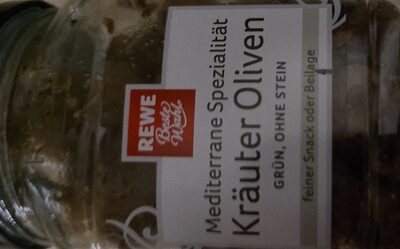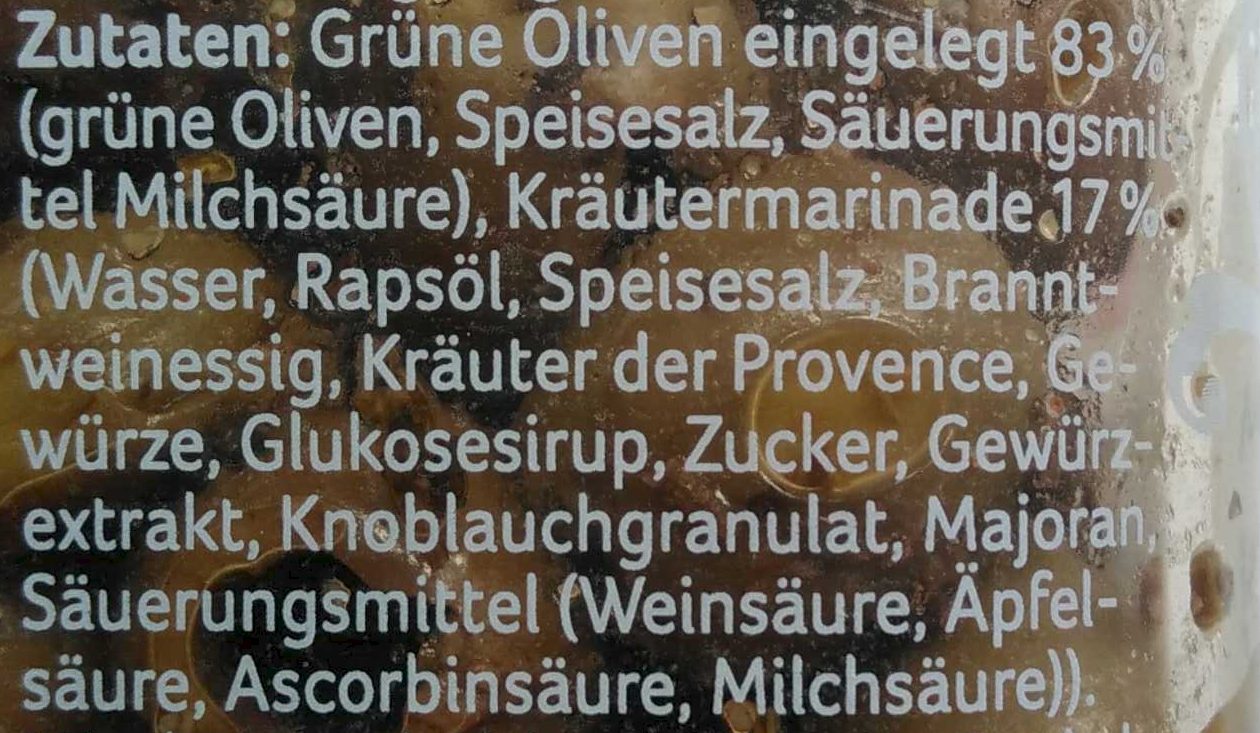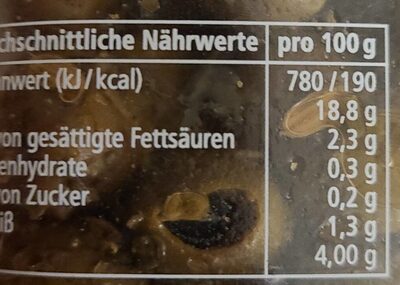Help us make food transparency the norm!
As a non-profit organization, we depend on your donations to continue informing consumers around the world about what they eat.
The food revolution starts with you!
Kräuter oliven - Rewe Beste Wahl - 150 g
Kräuter oliven - Rewe Beste Wahl - 150 g
This product page is not complete. You can help to complete it by editing it and adding more data from the photos we have, or by taking more photos using the app for Android or iPhone/iPad. Thank you!
×
Barcode: 4388844083165 (EAN / EAN-13)
Common name: Kräuter-Oliven grün, ohne Stein, trocken eingelegt
Quantity: 150 g
Packaging: Glass
Brands: Rewe Beste Wahl, Rewe
Categories: Plant-based foods and beverages, Plant-based foods, Pickles, Olive tree products, Plant-based pickles, Olives, Green olives
Stores: Rewe
Countries where sold: Germany
Matching with your preferences
Health
Ingredients
-
22 ingredients
: Grüne Oliven eingelegt 83% (grüne Oliven, Speisesalz, Säuerungsmittel Milchsäure), Kräutermarinade 17% (Wasser, Rapsöl, Speisesalz, Branntweinessig, Kräter der Provence, Gewürze, Glukosesirup, Zucker, Gewürzextrakt, Knoblauchgranulat, Majoran, Säuerungsmittel (Weinsäure, Äpfelsäure, Ascorbinsäure, Milchsäure)).
Food processing
-
Ultra processed foods
Elements that indicate the product is in the 4 - Ultra processed food and drink products group:
- Ingredient: Glucose
- Ingredient: Glucose syrup
Food products are classified into 4 groups according to their degree of processing:
- Unprocessed or minimally processed foods
- Processed culinary ingredients
- Processed foods
- Ultra processed foods
The determination of the group is based on the category of the product and on the ingredients it contains.
Additives
-
E270 - Lactic acid
Lactic acid: Lactic acid is an organic compound with the formula CH3CH-OH-COOH. In its solid state, it is white and water-soluble. In its liquid state, it is colorless. It is produced both naturally and synthetically. With a hydroxyl group adjacent to the carboxyl group, lactic acid is classified as an alpha-hydroxy acid -AHA-. In the form of its conjugate base called lactate, it plays a role in several biochemical processes. In solution, it can ionize a proton from the carboxyl group, producing the lactate ion CH3CH-OH-CO−2. Compared to acetic acid, its pKa is 1 unit less, meaning lactic acid deprotonates ten times more easily than acetic acid does. This higher acidity is the consequence of the intramolecular hydrogen bonding between the α-hydroxyl and the carboxylate group. Lactic acid is chiral, consisting of two optical isomers. One is known as L--+--lactic acid or -S--lactic acid and the other, its mirror image, is D--−--lactic acid or -R--lactic acid. A mixture of the two in equal amounts is called DL-lactic acid, or racemic lactic acid. Lactic acid is hygroscopic. DL-lactic acid is miscible with water and with ethanol above its melting point which is around 17 or 18 °C. D-lactic acid and L-lactic acid have a higher melting point. In animals, L-lactate is constantly produced from pyruvate via the enzyme lactate dehydrogenase -LDH- in a process of fermentation during normal metabolism and exercise. It does not increase in concentration until the rate of lactate production exceeds the rate of lactate removal, which is governed by a number of factors, including monocarboxylate transporters, concentration and isoform of LDH, and oxidative capacity of tissues. The concentration of blood lactate is usually 1–2 mM at rest, but can rise to over 20 mM during intense exertion and as high as 25 mM afterward. In addition to other biological roles, L-lactic acid is the primary endogenous agonist of hydroxycarboxylic acid receptor 1 -HCA1-, which is a Gi/o-coupled G protein-coupled receptor -GPCR-.In industry, lactic acid fermentation is performed by lactic acid bacteria, which convert simple carbohydrates such as glucose, sucrose, or galactose to lactic acid. These bacteria can also grow in the mouth; the acid they produce is responsible for the tooth decay known as caries. In medicine, lactate is one of the main components of lactated Ringer's solution and Hartmann's solution. These intravenous fluids consist of sodium and potassium cations along with lactate and chloride anions in solution with distilled water, generally in concentrations isotonic with human blood. It is most commonly used for fluid resuscitation after blood loss due to trauma, surgery, or burns.Source: Wikipedia
-
E296 - Malic acid
Malic acid: Malic acid is an organic compound with the molecular formula C4H6O5. It is a dicarboxylic acid that is made by all living organisms, contributes to the pleasantly sour taste of fruits, and is used as a food additive. Malic acid has two stereoisomeric forms -L- and D-enantiomers-, though only the L-isomer exists naturally. The salts and esters of malic acid are known as malates. The malate anion is an intermediate in the citric acid cycle.Source: Wikipedia
-
E334 - L(+)-tartaric acid
Tartaric acid: Tartaric acid is a white, crystalline organic acid that occurs naturally in many fruits, most notably in grapes, but also in bananas, tamarinds, and citrus. Its salt, potassium bitartrate, commonly known as cream of tartar, develops naturally in the process of winemaking. It is commonly mixed with sodium bicarbonate and is sold as baking powder used as a leavening agent in food preparation. The acid itself is added to foods as an antioxidant and to impart its distinctive sour taste. Tartaric is an alpha-hydroxy-carboxylic acid, is diprotic and aldaric in acid characteristics, and is a dihydroxyl derivative of succinic acid.Source: Wikipedia
Ingredients analysis
-
Palm oil content unknown
Unrecognized ingredients: de:kräutermarinade, de:kräter-der-provenceSome ingredients could not be recognized.
We need your help!
You can help us recognize more ingredients and better analyze the list of ingredients for this product and others:
- Edit this product page to correct spelling mistakes in the ingredients list, and/or to remove ingredients in other languages and sentences that are not related to the ingredients.
- Add new entries, synonyms or translations to our multilingual lists of ingredients, ingredient processing methods, and labels.
If you would like to help, join the #ingredients channel on our Slack discussion space and/or learn about ingredients analysis on our wiki. Thank you!
-
Vegan status unknown
Unrecognized ingredients: de:kräutermarinade, de:kräter-der-provenceSome ingredients could not be recognized.
We need your help!
You can help us recognize more ingredients and better analyze the list of ingredients for this product and others:
- Edit this product page to correct spelling mistakes in the ingredients list, and/or to remove ingredients in other languages and sentences that are not related to the ingredients.
- Add new entries, synonyms or translations to our multilingual lists of ingredients, ingredient processing methods, and labels.
If you would like to help, join the #ingredients channel on our Slack discussion space and/or learn about ingredients analysis on our wiki. Thank you!
-
Vegetarian status unknown
Unrecognized ingredients: de:kräutermarinade, de:kräter-der-provenceSome ingredients could not be recognized.
We need your help!
You can help us recognize more ingredients and better analyze the list of ingredients for this product and others:
- Edit this product page to correct spelling mistakes in the ingredients list, and/or to remove ingredients in other languages and sentences that are not related to the ingredients.
- Add new entries, synonyms or translations to our multilingual lists of ingredients, ingredient processing methods, and labels.
If you would like to help, join the #ingredients channel on our Slack discussion space and/or learn about ingredients analysis on our wiki. Thank you!
-
Details of the analysis of the ingredients
We need your help!
Some ingredients could not be recognized.
We need your help!
You can help us recognize more ingredients and better analyze the list of ingredients for this product and others:
- Edit this product page to correct spelling mistakes in the ingredients list, and/or to remove ingredients in other languages and sentences that are not related to the ingredients.
- Add new entries, synonyms or translations to our multilingual lists of ingredients, ingredient processing methods, and labels.
If you would like to help, join the #ingredients channel on our Slack discussion space and/or learn about ingredients analysis on our wiki. Thank you!
: Grüne Oliven 83% (grüne Oliven, Speisesalz, Säuerungsmittel (Milchsäure)), Kräutermarinade 17% (Wasser, Rapsöl, Speisesalz, Branntweinessig, Kräter der Provence, Gewürze, Glukosesirup, Zucker, Gewürzextrakt, Knoblauch, Majoran, Säuerungsmittel (Weinsäure, Äpfelsäure, Ascorbinsäure, Milchsäure))- Grüne Oliven -> en:green-olive - vegan: yes - vegetarian: yes - ciqual_food_code: 13033 - percent_min: 83 - percent: 83 - percent_max: 83
- grüne Oliven -> en:green-olive - vegan: yes - vegetarian: yes - ciqual_food_code: 13033 - percent_min: 27.6666666666667 - percent_max: 83
- Speisesalz -> en:salt - vegan: yes - vegetarian: yes - ciqual_food_code: 11058 - percent_min: 0 - percent_max: 41.5
- Säuerungsmittel -> en:acid - percent_min: 0 - percent_max: 27.6666666666667
- Milchsäure -> en:e270 - vegan: yes - vegetarian: yes - percent_min: 0 - percent_max: 27.6666666666667
- Kräutermarinade -> de:kräutermarinade - percent_min: 17 - percent: 17 - percent_max: 17
- Wasser -> en:water - vegan: yes - vegetarian: yes - ciqual_food_code: 18066 - percent_min: 1.41666666666667 - percent_max: 17
- Rapsöl -> en:rapeseed-oil - vegan: yes - vegetarian: yes - from_palm_oil: no - percent_min: 0 - percent_max: 8.5
- Speisesalz -> en:salt - vegan: yes - vegetarian: yes - ciqual_food_code: 11058 - percent_min: 0 - percent_max: 5.66666666666667
- Branntweinessig -> en:spirit-vinegar - vegan: yes - vegetarian: yes - ciqual_food_code: 11018 - percent_min: 0 - percent_max: 4.25
- Kräter der Provence -> de:kräter-der-provence - percent_min: 0 - percent_max: 3.4
- Gewürze -> en:spice - vegan: yes - vegetarian: yes - percent_min: 0 - percent_max: 2.83333333333333
- Glukosesirup -> en:glucose-syrup - vegan: yes - vegetarian: yes - ciqual_proxy_food_code: 31016 - percent_min: 0 - percent_max: 2.42857142857143
- Zucker -> en:sugar - vegan: yes - vegetarian: yes - ciqual_proxy_food_code: 31016 - percent_min: 0 - percent_max: 0.2
- Gewürzextrakt -> en:spice-extract - vegan: yes - vegetarian: yes - percent_min: 0 - percent_max: 0.2
- Knoblauch -> en:garlic - vegan: yes - vegetarian: yes - ciqual_food_code: 11000 - percent_min: 0 - percent_max: 0.2
- Majoran -> en:marjoram - vegan: yes - vegetarian: yes - percent_min: 0 - percent_max: 0.2
- Säuerungsmittel -> en:acid - percent_min: 0 - percent_max: 0.2
- Weinsäure -> en:e334 - vegan: yes - vegetarian: yes - percent_min: 0 - percent_max: 0.2
- Äpfelsäure -> en:e296 - vegan: yes - vegetarian: yes - percent_min: 0 - percent_max: 0.2
- Ascorbinsäure -> en:e300 - vegan: yes - vegetarian: yes - percent_min: 0 - percent_max: 0.0666666666666667
- Milchsäure -> en:e270 - vegan: yes - vegetarian: yes - percent_min: 0 - percent_max: 0.05
Nutrition
-
Missing data to compute the Nutri-Score
Missing nutrition facts
⚠ ️The nutrition facts of the product must be specified in order to compute the Nutri-Score.Could you add the information needed to compute the Nutri-Score? Add nutrition facts
-
Nutrient levels
-
Fat in moderate quantity (18.8%)
What you need to know- A high consumption of fat, especially saturated fats, can raise cholesterol, which increases the risk of heart diseases.
Recommendation: Limit the consumption of fat and saturated fat- Choose products with lower fat and saturated fat content.
-
Saturated fat in moderate quantity (2.3%)
What you need to know- A high consumption of fat, especially saturated fats, can raise cholesterol, which increases the risk of heart diseases.
Recommendation: Limit the consumption of fat and saturated fat- Choose products with lower fat and saturated fat content.
-
Sugars in low quantity (0.2%)
What you need to know- A high consumption of sugar can cause weight gain and tooth decay. It also augments the risk of type 2 diabetes and cardio-vascular diseases.
Recommendation: Limit the consumption of sugar and sugary drinks- Sugary drinks (such as sodas, fruit beverages, and fruit juices and nectars) should be limited as much as possible (no more than 1 glass a day).
- Choose products with lower sugar content and reduce the consumption of products with added sugars.
-
-
Nutrition facts
Nutrition facts As sold
for 100 g / 100 mlCompared to: Green olives Energy 780 kj
(190 kcal)+17% Fat 18.8 g +19% Saturated fat 2.3 g -12% Carbohydrates 0.3 g -80% Sugars 0.2 g +7% Fiber ? Proteins 1.3 g +7% Salt ? Fruits‚ vegetables‚ nuts and rapeseed‚ walnut and olive oils (estimate from ingredients list analysis) 86.911 %
Environment
-
Eco-Score A - Very low environmental impact
⚠ ️Select a country in order to include the full impact of transportation.The Eco-Score is an experimental score that summarizes the environmental impacts of food products.→ The Eco-Score was initially developped for France and it is being extended to other European countries. The Eco-Score formula is subject to change as it is regularly improved to make it more precise and better suited to each country.Life cycle analysis
-
Average impact of products of the same category: A (Score: 95/100)
Category: Olive, green, stuffed (anchovy, sweet peppers, etc…)
Category: Olive, green, stuffed (anchovy, sweet peppers, etc…)
- PEF environmental score: 0.13 (the lower the score, the lower the impact)
- including impact on climate change: 0.89 kg CO2 eq/kg of product
Stage Impact Agriculture
32.4 %Processing
0.2 %Packaging
40.2 %Transportation
18.4 %Distribution
6.9 %Consumption
1.9 %
Bonuses and maluses
-
Missing origins of ingredients information
Malus: -5
⚠ ️ The origins of the ingredients of this product are not indicated.
If they are indicated on the packaging, you can modify the product sheet and add them.
If you are the manufacturer of this product, you can send us the information with our free platform for producers.
-
Packaging with a low impact
Malus: -2
Shape Material Recycling Impact Unknown Glass Low ⚠ ️ The information about the packaging of this product is not sufficiently precise (exact shapes and materials of all components of the packaging).⚠ ️ For a more precise calculation of the Eco-Score, you can modify the product page and add them.
If you are the manufacturer of this product, you can send us the information with our free platform for producers.
Eco-Score for this product
-
Impact for this product: A (Score: 88/100)
Product: Kräuter oliven - Rewe Beste Wahl - 150 g
Life cycle analysis score: 95
Sum of bonuses and maluses: -7
Final score: 88/100
-
Carbon footprint
-
Equal to driving 0.5 km in a petrol car
89 g CO² per 100g of product
The carbon emission figure comes from ADEME's Agribalyse database, for the category: Olive, green, stuffed (anchovy, sweet peppers, etc…) (Source: ADEME Agribalyse Database)
Stage Impact Agriculture
4.9 %Processing
0.0 %Packaging
55.8 %Transportation
34.4 %Distribution
4.2 %Consumption
0.7 %
Packaging
-
Packaging with a low impact
-
Packaging parts
(Glass)
-
Packaging materials
Material % Packaging weight Packaging weight per 100 g of product Glass
-
Transportation
-
Origins of ingredients
Missing origins of ingredients information
⚠ ️ The origins of the ingredients of this product are not indicated.
If they are indicated on the packaging, you can modify the product sheet and add them.
If you are the manufacturer of this product, you can send us the information with our free platform for producers.Add the origins of ingredients for this product Add the origins of ingredients for this product
Report a problem
-
Incomplete or incorrect information?
Category, labels, ingredients, allergens, nutritional information, photos etc.
If the information does not match the information on the packaging, please complete or correct it. Open Food Facts is a collaborative database, and every contribution is useful for all.
Data sources
Product added on by kakao
Last edit of product page on by packbot.
Product page also edited by ecoscore-impact-estimator, foodrepo, kiliweb, yuka.sY2b0xO6T85zoF3NwEKvlh18bvD5ow7iEgffgW2QyYqrD7yxaOFgyKrHD6s.










